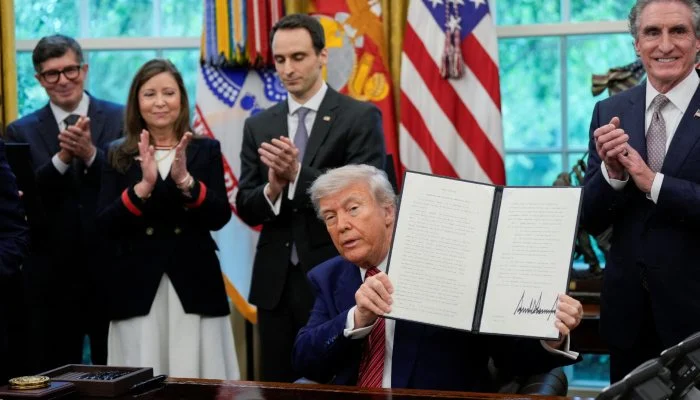United States President Donald Trump on Friday directed the nation’s independent nuclear regulatory commission to streamline regulations and expedite the licensing process for new reactors and power plants, aiming to reduce the multi-year procedure to just 18 months.
This directive was part of a series of executive orders signed by Trump on Friday, designed to boost U.S. nuclear energy output amidst a surge in demand from data centers and artificial intelligence technologies.
Currently, obtaining licenses for reactors in the U.S. can frequently extend beyond a decade. While this lengthy process is intended to prioritize nuclear safety, it has simultaneously deterred the initiation of new projects.
“This is going to turn the clock back on over 50 years of overregulation of an industry,” stated United States Interior Secretary Doug Burgum, who chairs the White House Energy Dominance Council, from the Oval Office.
These actions encompass a significant restructuring of the Nuclear Regulatory Commission, including a review of its staffing levels. They also instruct the Energy and Defense departments to collaborate on constructing nuclear plants on federal lands.
A senior White House official indicated that the administration envisions the Department of Defense taking a prominent role in commissioning reactors and installing them on military bases.
Furthermore, the orders seek to revitalize uranium production and enrichment within the United States.
Joseph Dominguez, CEO of U.S. nuclear power operator Constellation Energy, commented that the president’s directives would contribute to normalizing the regulatory process.
“We’re wasting too much time on permitting, and we’re answering silly questions, not the important ones,” Dominguez remarked during the signing event.
The U.S. and other nations have intensified nuclear power regulation in recent decades, partly as a consequence of reactor incidents such as the meltdown at the Chernobyl plant in the former Soviet Union in 1986, and the partial meltdown at the Three Mile Island plant in the United States in 1979.
Developers are now also exploring the deployment of advanced nuclear technologies like small modular reactors (SMRs), which hold the potential for quicker and more cost-effective construction compared to traditional plants, though they might introduce novel safety considerations.
Ernest Moniz, a nuclear physicist supportive of the industry and former U.S. Energy Secretary, cautioned, “Reorganizing and reducing the independence of the NRC could lead to the hasty deployment of advanced reactors with safety and security flaws.”
He further warned, “A major event would, like those in the past, increase regulatory requirements and set back nuclear energy for a long time.”
As one of his initial acts in office, Trump declared a national energy emergency in January, asserting that the U.S. possessed insufficient electricity supplies to meet the nation’s escalating demands, especially from data centers powering artificial intelligence systems.
While most of Trump’s initiatives have concentrated on enhancing fossil fuels like coal, oil, and natural gas, administration officials also advocate for nuclear power, which has garnered increasing bipartisan support in recent years.
Some Democrats endorse nuclear energy due to its lack of planet-warming greenhouse gas emissions, even as environmentalists have raised concerns regarding radioactive waste and reactor safety.
Republicans, less preoccupied with global warming, support nuclear power, arguing that nuclear plants can bolster U.S. energy security.
However, cost and competition have posed significant obstacles to new nuclear projects, and it remains uncertain whether Trump’s orders will be sufficient to overcome these challenges.
NuScale SMR.N, the sole U.S. company with an SMR design approved by regulators, abandoned its project in 2023 due to escalating costs and competition from plants fueled by abundant natural gas.
Meanwhile, Vogtle, the most recent U.S. reactor to become operational, incurred approximately $16 billion in cost overruns and experienced years of delays.
The Loan Programs Office, which the administration intends to utilize for financing reactor projects that banks are unwilling to support, has been severely impacted by Trump’s recent job layoffs.



